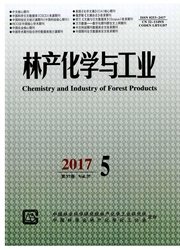

 中文摘要:
中文摘要:
为了研究烟杆炭化过程和产物炭的结构特征,采用热重分析(TGA)考察了烟杆的热解行为,并用X射线衍射对产物烟杆炭的结构进行了研究,同时还讨论了炭化温度(773~1 773 K)对烟杆炭结构的影响,提出了烟杆炭化过程的结构模型,探讨了烟杆的炭化机理.研究结果表明,烟杆在N2气氛中的热分解开始于 433 K 左右,在470~660 K 范围内热解最为剧烈,且在 943 K 时热解反应基本结束,烟杆在 1 273 K 下热分解后的残炭率为 27.15 %;烟杆炭的XRD谱图中只存在(002)、(100)和(110)3个弥散的衍射峰,是一种典型的难石墨化炭材料,并且炭化温度越高,烟杆炭中的石墨状微晶其平均层间距d002越小,随炭化温度的变化,微晶层面沿c轴方向的堆积厚底(Lc)和沿a轴方向的微晶直径(La)分别在0.66~1.24 nm 和2.64~4.26 nm 之间变化,表明烟杆炭中的石墨状微晶c轴方向平均可堆积2~4层六角碳网层面,而a轴方向约含有10~18个芳环.
 英文摘要:
英文摘要:
Thermogravimetric analysis (TGA) and X-ray diffraction (XRD) techniques have been applied to investigate thermal degradation characteristics of tobacco stems (TS) and the structure of its charcoal at different carbonization temperatures, respectively. The effect of carbonization temperature on the structure of the tobacco stems-based charcoal (TSC) and carbonization mechanism of TS were discussed. Based on the results of TGA and XRD, a simple model of TS carbonization was derived. Experimental results show that weight loss during heating of dried TS in N2 atmosphere starts below 433 K and is almost terminated at 943 K, and the maximum decomposition rate in the temperature range 470-660 K could be determined by differential thermogravimetric (DTG) curve, and almost 72.85 % of the total weight loss occurs in 298-1 273 K. The XRD patterns of TSCs showed three broad peaks (002), (100) and ( 110),which are typical of turbostratic layering and non-graphitic carbon. With increasing of carbonization temperature, the interlayer spacing of aromatic layers (d002 ) is decreasing, and the crystallite sizes Le and La are changing in the ranges of 0.66-1.24 nm and 2.64-4.26 nm, respectively, which implied that there are about 2-4 graphene layers along c-axis and 10-18 aromatic rings along a-axis in crystallite of TSCs.
 同期刊论文项目
同期刊论文项目
 同项目期刊论文
同项目期刊论文
 期刊信息
期刊信息
